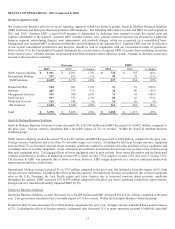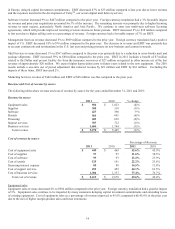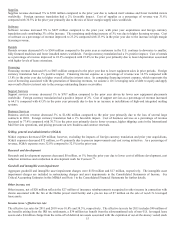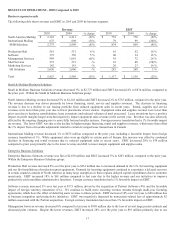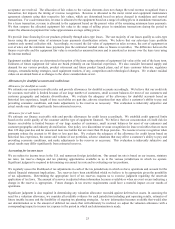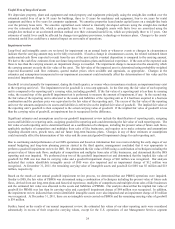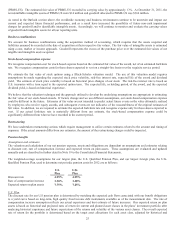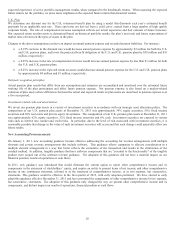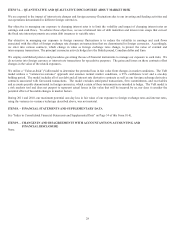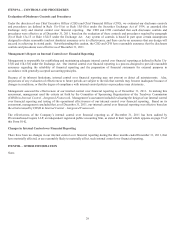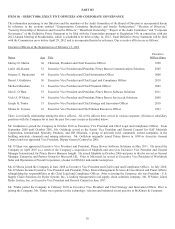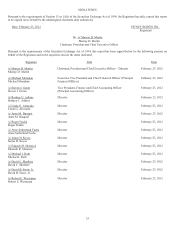Pitney Bowes 2011 Annual Report Download - page 41
Download and view the complete annual report
Please find page 41 of the 2011 Pitney Bowes annual report below. You can navigate through the pages in the report by either clicking on the pages listed below, or by using the keyword search tool below to find specific information within the annual report. 23
acceptance are resolved. The allocation of fair values to the various elements does not change the total revenue recognized from a
transaction, but impacts the timing of revenue recognition. Revenue is allocated to the meter rental and equipment maintenance
agreement elements using their respective fair values, which are determined based on prices charged in standalone and renewal
transactions. For a sale transaction, revenue is allocated to the equipment based on a range of selling prices in standalone transactions.
For a lease transaction, revenue is allocated to the equipment based on the present value of the remaining minimum lease payments.
We then compare the allocated equipment fair value to the range of selling prices in standalone transactions during the period to
ensure the allocated equipment fair value approximates average selling prices.
We provide lease financing for our products primarily through sales-type leases. The vast majority of our leases qualify as sales-type
leases using the present value of minimum lease payments classification criteria. We believe that our sales-type lease portfolio
contains only normal collection risk. Accordingly, we record the fair value of equipment as sales revenue, the cost of equipment as
cost of sales and the minimum lease payments plus the estimated residual value as finance receivables. The difference between the
finance receivable and the equipment fair value is recorded as unearned income and is amortized as income over the lease term using
the interest method.
Equipment residual values are determined at inception of the lease using estimates of equipment fair value at the end of the lease term.
Estimates of future equipment fair value are based primarily on our historical experience. We also consider forecasted supply and
demand for our various products, product retirement and future product launch plans, end of lease customer behavior, regulatory
changes, remanufacturing strategies, used equipment markets, if any, competition and technological changes. We evaluate residual
values on an annual basis or as changes to the above considerations occur.
Allowances for doubtful accounts and credit losses
Allowance for doubtful accounts
We estimate our accounts receivable risks and provide allowances for doubtful accounts accordingly. We believe that our credit risk
for accounts receivable is limited because of our large number of customers, small account balances for most of our customers and
customer geographic and industry diversification. We evaluate the adequacy of the allowance for doubtful accounts based on
historical loss experience, length of time receivables are past due, adverse situations that may affect a customer’s ability to pay and
prevailing economic conditions, and make adjustments to the reserves as necessary. This evaluation is inherently subjective and
actual results may differ significantly from estimated reserves.
Allowance for credit losses
We estimate our finance receivable risks and provide allowances for credit losses accordingly. We establish credit approval limits
based on the credit quality of the customer and the type of equipment financed. We believe that our concentration of credit risk for
finance receivables is limited because of our large number of customers, small account balances for most of our customers and
customer geographic and industry diversification. Our policy is to discontinue revenue recognition for lease receivables that are more
than 120 days past due and for unsecured loan receivables that are more than 90 days past due. We resume revenue recognition when
payments reduce the account to 60 days or less past due. We evaluate the adequacy of the allowance for credit losses based on
historical loss experience, the nature and volume of our portfolios, adverse situations that may affect a customer’s ability to pay and
prevailing economic conditions, and make adjustments to the reserves as necessary. This evaluation is inherently subjective and
actual results may differ significantly from estimated reserves.
Accounting for income taxes
We are subject to income taxes in the U.S. and numerous foreign jurisdictions. Our annual tax rate is based on our income, statutory
tax rates, tax reserve changes and tax planning opportunities available to us in the various jurisdictions in which we operate.
Significant judgment is required in determining our annual tax rate and in evaluating our tax positions.
We regularly assess the likelihood of tax adjustments in each of the tax jurisdictions in which we have operations and account for the
related financial statement implications. Tax reserves have been established which we believe to be appropriate given the possibility
of tax adjustments. Determining the appropriate level of tax reserves requires us to exercise judgment regarding the uncertain
application of tax laws. The amount of reserves is adjusted when information becomes available or when an event occurs indicating a
change in the reserve is appropriate. Future changes in tax reserve requirements could have a material impact on our results of
operations.
Significant judgment is also required in determining any valuation allowance recorded against deferred tax assets. In assessing the
need for a valuation allowance, we consider all available evidence for each jurisdiction including past operating results, estimates of
future taxable income and the feasibility of ongoing tax planning strategies. As new information becomes available that would alter
our determination as to the amount of deferred tax assets that will ultimately be realized, we adjust the valuation allowance with a
corresponding impact to income tax expense in the period in which such determination is made.


